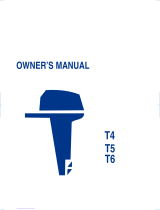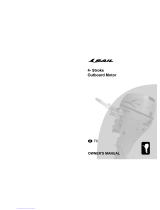
Table of contents
Power trim and tilt switches
(twin type) ..................................... 33
Trim tab with anode ........................ 33
Tilt support lever for power trim
and tilt model ................................ 34
Cowling lock lever ........................... 34
Flushing device ............................... 34
Fuel filter ......................................... 35
Instruments and indicators ............ 36
Command Link Plus Display .......... 36
Engine warm-up indicator ............... 36
Engine synchronization indicator .... 36
Overheat alert ................................. 36
Low oil pressure-alert...................... 37
Water separator alert ...................... 37
Low battery voltage-alert................. 38
Engine trouble alert......................... 38
Command Link Multifunction
Meters ..........................................39
Command Link Multifunction
Tachometer .................................. 39
Low oil pressure-alert...................... 40
Overheat alert ................................. 40
Water separator alert ...................... 41
Engine trouble alert......................... 41
Low battery voltage-alert................. 42
Command Link Multifunction
Speed & Fuel Meter ..................... 42
Command Link Multifunction
Speedometer43
Command Link Multifunction Fuel
Management Meter ...................... 44
Optional meters.............................. 44
Engine control system.................... 46
Alert system ...................................46
Digital Electronic Control alert......... 46
Overheat alert ................................. 46
Low oil pressure alert...................... 47
Water separator alert ...................... 48
Installation ....................................... 50
Installation ......................................50
Mounting the outboard motor.......... 50
Operation ......................................... 52
First-time operation ........................ 52
Filling engine oil .............................. 52
Breaking in engine .......................... 52
Getting to know your boat ............... 52
Checks before starting engine ....... 52
Fuel level......................................... 53
Removing top cowling ..................... 53
Fuel system..................................... 53
Controls........................................... 54
Engine shut-off cord (lanyard)......... 54
Engine oil ........................................ 54
Outboard motor ............................... 55
Flushing device ............................... 55
Installing top cowling ....................... 55
Checking power trim and tilt
system........................................... 57
Battery............................................. 57
Filling fuel ...................................... 58
Operating engine ........................... 58
Sending fuel .................................... 58
Starting engine ................................ 58
Checks after starting engine .......... 60
Cooling water .................................. 60
Warming up engine........................ 61
Electric start models........................ 61
Checks after engine warm up ........ 61
Shifting ............................................ 61
Stop switches .................................. 61
Shifting........................................... 61
Stopping boat................................. 62
Trolling ........................................... 62
Adjusting trolling speed ................... 62
Stopping engine............................. 63
Procedure for stopping engine ........ 63
Trimming outboard motor............... 64
Adjusting trim angle (Power trim
and tilt) .......................................... 64
Adjusting boat trim .......................... 65
Tilting up and down........................ 66
Procedure for tilting up (power trim
and tilt models).............................. 66
Procedure for tilting down (power
trim and tilt models)....................... 67
Shallow water ................................ 68
Cruising in shallow water ................ 68
Operating in other conditions......... 69
6CE-9-34-1E0.book 2 ページ 2012年11月23日 金曜日 午後1時13分





















